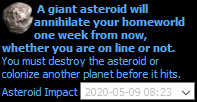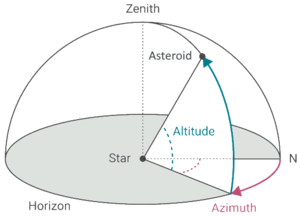Asteroid: Difference between revisions
m (→Locating The Asteroid: Renamed section.) |
(→Locating The Asteroid: Added picture.) |
||
| Line 55: | Line 55: | ||
===Locating The Asteroid=== | ===Locating The Asteroid=== | ||
[[File:AsteroidLocationCalculation.png|thumb|right|Math can save the world.]] | |||
When the asteroid is not within sensor range it can be hard to find. However a city with an [[observatory]] will give a detailed report about where an asteroid is and how fast it is moving in the [[City_Report|city report]]. | When the asteroid is not within sensor range it can be hard to find. However a city with an [[observatory]] will give a detailed report about where an asteroid is and how fast it is moving in the [[City_Report|city report]]. | ||
Revision as of 07:09, 23 August 2020

The asteroid is an event that starts when a new avatar enters the universe. Their starting world will be in danger and need saving.
The asteroid is explained by the stargazer of a village.
Time Until Impact

During avatar creation it is possible to adjust the scheduled asteroid impact time. It can be adjusted between 6½ and 7½ days from when the avatar first spawns on their first world. It is recommended to select late time so you have time to react in the few critical hours prior to impact.
Detection
Cities with an observatory report the presence of an asteroid in its solar system, which is necessary to detect asteroids at extreme range. Asteroids known to be on a collision course with a world will cause an event log alert in the city report.
If a space station with sensors or a city with radar detect asteroids within sensor range, they will report them and their location in their event log.
Appearance
The asteroid won't physically spawns in the solar system until the the last 8 hours before the scheduled time. The asteroid will at first spawn around 50 AU away and travel at ~1000m/s towards the homeworld. The travel speed with automatically increase and decrease to ensure the asteroid will impact with the homeworld it is locked onto at the exact scheduled time.
The asteroid is marked as enemy, and can thus be targeted from a fire control station. It will also appear on the Unit list for attack and follow orders.
Impact
Depending upon the size difference between the asteroid and the world world being impacted, devastation could range from destruction of all cities on the world, to complete annihilation of the world body.
Asteroids of any size is are absorbed by gas giants harmlessly.
Extinction Level Event
When a smaller asteroid impacts a world it will create a huge crater, and all cities and buildings on the world are destroyed.
World Annihilation
If a planet is destroyed, it will turn into an asteroid belt with possibly a tiny planetoid world in it.
The moons of a world are unharmed, unless subsequently hit by another asteroid. They will spin on an additional axis and tumble in the asteroid belt.
If a moon or titan is destroyed by an asteroid impact, it will become a planetary ring. A planetary ring that is left behind when its planet is destroyed will disappear.
The system survey and star map XML export of the solar system with the destroyed world will still show the system as it was originally created. To obtain the proper resource information for any remnants of the world, you'll need to perform a manual scan with the sensor station. According to Haxus, this is because "The system scan is generated based on a seed value. It doesn't know the planet was destroyed."
Impact Avoidance
The goal is to develop the needed technology to get into space and either destroy the asteroid or evacuate the homeworld.
Asteroid Destruction
The asteroid can be attacked with space fighters, a spacecraft with weapons, or military weapon systems.
Spacecraft
A spacecraft with energy weapons is highly recommended.
Projectile weapons aren't reliable enough to be used by the crew alone and might require some manual piloting to get extra close or in front of the asteroid.
Space Fighter
While it is possible to destroy an asteroid with a space fighter, it is extremely difficult to locate it with just a space fighter alone. By the time the asteroid is within visual range it might be too late, spotting an asteroid from a far takes some skill.
Using a spacecraft with sensors and a hangar for the space fighter makes it a lot easier to locate and get to the asteroid while it is still at a safe distance.
Military Weapon System
It is not recommended to rely on military weapon systems to defend against an asteroids, as they will not be able to damage the asteroid enough by the time it gets into range.[1] At most it can downgrade it from a world destroyer asteroid to multiple extinction level asteroids right before impact. And that is assuming that the asteroid is even gonna impact the same side of the planet as the military weapon system.
Locating The Asteroid

When the asteroid is not within sensor range it can be hard to find. However a city with an observatory will give a detailed report about where an asteroid is and how fast it is moving in the city report.
Hazardous asteroid observed! Orbit collides with (world name) (time and date) GMT. 6,096.0m diameter. 998.8m/s velocity. Spotted SE at 128°, azimuth -26°, 18,929,783m away relative to the solar system plane of ecliptic.
Using a little math it is possible to calculate the exact coordinates of the asteroid.[2]
I'm denoting the first angle reported as A, the second angle as B and the distance as D.
I'm also using degrees here. If you're putting this into a spreadsheet it may assume radians so you'll need to multiply the angles by π/180.
One AU is 724205m. The asteroid distance is given in m and we need the coordinates in AU, so that's why the division is there.Asteroid X = sin(A)*cos(B)*D/724205
Asteroid Y = cos(A)*cos(B)*D/724205
Asteroid Z = sin(B)*D/724205
Breaking Apart and Smaller Asteroids
The asteroid will break apart into smaller asteroid pieces as it is damaged. These smaller asteroids will not be locked onto the homeworld, but will have some of the same trajectory as the original asteroid. in most cases smaller asteroids will simply be pulled in by the gravity of larger celestial objects, such as a sun or gas giant.
Easiest Defense
The easiest way to defend against an asteroid is with a spacecraft and energy weapon bay technology.
A spacecraft stationed in orbit with an energy weapon bay, system ranged sensors and a commanding officer will be able to take care of an incoming asteroid on its own. The officer will automatically order the crew to attack the asteroid once it is in sensor range.
Note: An easy way to gather the resources needed by energy weapon bay and lens is to make small colonies on inferno and frigid planets of your starting system. This way you only have to put down an airport terminal to instantly get any resource from your main city. It makes it easier to colonize and build a decent mining colony. Don't be shy about corrosive atmospheres. Use pressure tents to be safe from the corrosive effects.
References
Haxus visited the homeworld of Tamunshin to help with an asteroid, however they were unable to destroy it before the impact. Haxus recorded a video of the impact which can be seen here: http://hazeron.com/Playlists/Scenes%20of%20Hazeron/AsteroidImpact.mp4
Also, this was discussed in this thread on the forums: http://hazeron.com/mybb/showthread.php?tid=2062